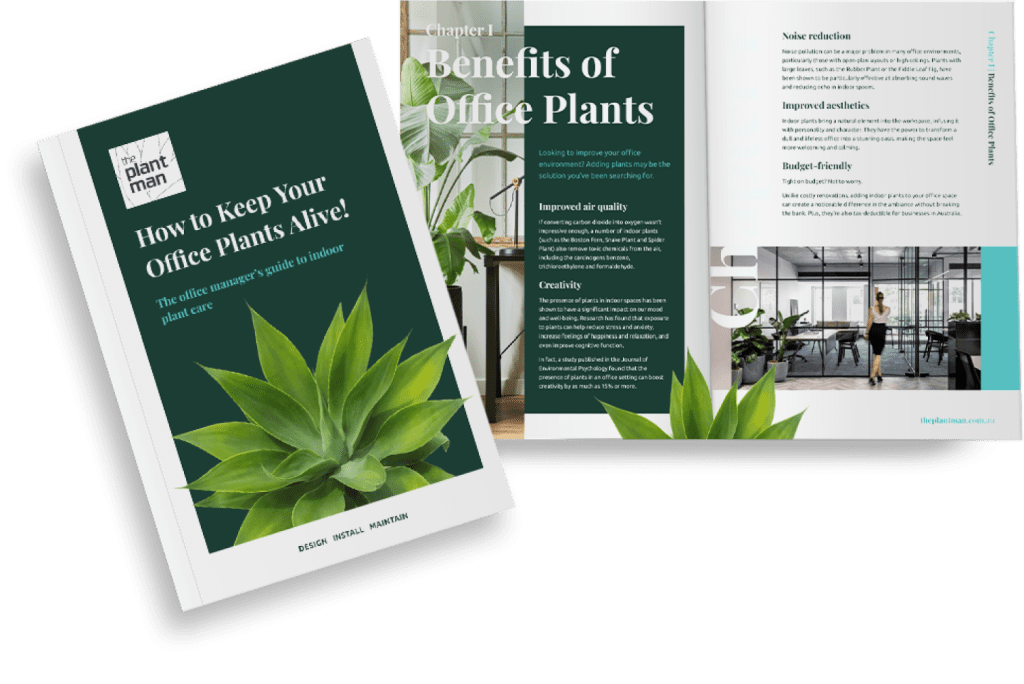We’re thankful that there are always plants to clean the air that we breathe.
When we think about air pollution these days in Sydney, we usually picture smoke and fumes from bushfires, vehicles and industry, rather than the air inside. However, depending on where you live and work, the air you breathe in your home or office could be dirtier than the air outside, which puts you at a greater risk of developing a number of health problems.
Indoor air pollution is a growing concern in Australian homes and workplaces. Studies have shown that levels of toxins from harmful chemicals including carbon dioxide, carbon monoxide, formaldehyde, benzene and other VOCs are higher indoors than outdoors.
This indoor air pollution is caused by cleaning products, perfumes, air fresheners, materials in the building such as paint and carpets, secondhand tobacco smoke, toxic chemicals, mould, dust, and other contaminants like bushfire smoke.
Why does indoor air quality matter?
Have you ever got a headache from paint fumes or someone wearing overpowering perfume? These are obvious signs that indoor air pollution is affecting your health, albeit temporarily.
However, many of the health consequences of breathing in these toxins on a daily basis for months and years are not so immediately obvious. In fact you may not even notice that your home or workplace was affecting your health until you move house or get a different job and realise that your asthma improves or you stop getting headaches.
Most people spend a significant amount of time indoors. Whether inside the home or office, having poor air quality is critical for good health. Chemicals and pollutants may cause allergies and headaches. It can also lead to long-term health complications, such as respiratory diseases, heart problems and lung cancer. Clean air can also help prevent or alleviate chronic complications like asthma.
Indoor plants that clean the air and remove toxins
If you’re worried about indoor air pollution at home or in your office, there are a few different things you can do to limit your exposure to impure air. Improving ventilation by opening windows is an obvious step, although this isn’t always possible when the outside air is contaminated by bushfires – a common concern in the Australian summer. You can also cut down on the chemical products you use and substitute eco-friendly natural cleaning materials, which are better for both the environment and your health.
Using indoor air cleaning plants is another simple way to improve indoor air quality. Plants absorb carbon dioxide from the air, which they combine with water and light to produce energy from growth. A famous study carried out by NASA demonstrated that they also filter out toxins from the air by absorbing them through their leaves.
The study identified 50 outdoor and indoor plants that clean the air, although most families of plants filter toxins to at least some degree. The best indoor plants for air purification tend to be those with lots of leaves, as it is the leaves that absorb gases from the air. Even cut plants can still produce a level of oxygen, making those office floral arrangements all the more worthwhile.
Best indoor plants for air purification in Australia
Looking for some new houseplants to improve the air quality of your home or office? Here are some good indoor plants for clean air that you should definitely consider incorporating into your living or work spaces:
Peace lily (indoors)
Peace lilies are an attractive flowering plant with shiny green leaves. These indoor plants thrive in low light and just need weekly watering to keep them healthy. However, be aware that they are poisonous to cats and dogs – so if you have a furry housemate or colleague, keep your peace lily far out of their reach. These plants are particularly great at removing toxins from the air including formaldehyde, benzene, trichloroethylene, and xylene.
Snake plant (indoors and outdoors)
With their upright foliage and tall frame, snake plants are visually appealing both indoors and outdoors and come with the added bonus that they require very minimum maintenance. Snake plants are well-known as one of the best indoor plants that clean the air. In fact, snake plants are one of the few indoor plants that can convert CO2 into oxygen during the nighttime.
Spider plant (indoors)
Spider plants are famous for many of their attributes: sprawling green leaves, low-maintenance nature, and their capability to remove formaldehyde and xylene for the air. If you haven’t finetuned your green thumb just yet, a spider plant can be a great first addition to your indoor plant collection. Just make sure you keep your spider plant away from direct sunlight.
English ivy (best outdoors)
English Ivy is a common outdoor plant that can be grown in hanging baskets or against a wall. As an expert multitasker, it’s also a pretty indoor plant and its long tendrils look particularly attractive hanging from a bookshelf. English Ivy removes formaldehyde and benzene from the air, and studies have shown that it’s also effective at reducing levels of airborne mould spores.
Areca Palm (best outdoors)
Many palms score highly on their ability to remove toxins from the air and the Areca is no exception. The Areca or Butterfly Palm can grow up to 4m high, so it’s a great statement plant for either your garden or your room. It’s highly effective at reducing toluene and xylene levels in the air, and they look particularly stunning in planter boxes lined along your balcony.
Boston fern (outdoor filtered light)
The delicate looking Boston Fern prefers humid environments, but those of us who don’t live in the tropics can still enjoy its company with regular misting to capture humidity. The Boston Fern is one of the best indoor plants for oxygen production and can also remove formaldehyde and xylene from the air.
Golden pothos (indoors)
The Golden Pothos looks as impressive as its name suggests. Its luscious leaves are known to be fantastic at reducing ozone levels in the air and it can also filter out benzene and formaldehyde. Considered one of the easiest indoor plants to grow, the Golden Pothos should be kept in moist but well-drained soil. They thrive in bright and indirect light.
Which plants give oxygen 24 hours?
Plants release oxygen during the day when their leaves capture sunlight, which sparks the process of photosynthesis. However, some of the best indoor plants for air quality go above and beyond in producing oxygen and actually generate it 24/7 – even in the absence of sunlight.
Want to add several of these oxygen obsessed, indoor plants that clean the air to collection? Some indoor plants that give oxygen at night include the Snake Plant, aloe vera, peepul, and the Areca Palm.
Which indoor plants generate the most oxygen?
Plants with leaves that have a larger surface area are typically known to be better at producing more oxygen.
Some plants that have been proven to generate higher amounts of oxygen include: aloe vera, Areca Palm, the spider plant, bamboo plant, tulsi, Snake Plant and many, many more.
How to choose the best indoor lighting for plants
If you want your plants to remove toxins from the air, you’ll have to first provide them with a healthy environment that supports them to do what they do best.
Lighting plants indoors can be tricky, but if you know which lights suit plants that clean the air best, you can achieve a good quality of air indoors.
Some of the lights you can use are good old fluorescent lights, compact fluorescent lights, LED lights, halides and incandescent lights. We’ll go into more detail about providing lighting for indoor plants good for air below.
Fluorescent Lights
Plants that need indirect sunlight such as the African violet can be lit with fluorescent lights from your ceiling or from an electric lampstand. These are also good for vegetables indoors. Choose tubelike bulbs and light it up between 4k-6k Kelvin.
Compact Fluorescent Lights
Compact fluorescent lights are T5 lights, which are a cheaper option when compared to other lighting fixtures. Compact fluorescent lights work well with carnivorous plants like the Venus Flytrap and the Yellow Pitcher.
Incandescent Lights
These types of lights, which are not recommended for buildings, can still be placed to pretty good use when supporting the growth of your indoor plant collection.
Incandescent lights are perfect for low-light houseplants like vines and ferns. However, there is a downside to this: incandescent lights use up more electricity than other types of lighting.
LED Lights
LED lights provide a full spectrum of lights at different levels of intensity. You can adjust the settings according to what your plant specifically needs. LED lights work mostly for plants that need indirect sunlight.
How many plants are needed to purify a room?
An interesting study from NASA in 1989 concluded that house plants can remove toxic substances like formaldehyde and benzene that could cause cancer. NASA Scientist Bill Wolverton stated that two big potted plants are needed for every 9.3 square metres of space indoors to purify the air. The study also concluded that air quality increased by 25% in a room with a one house plant while two plants improved the air quality indoors by 75%. On average, about 10 house plants are needed inside a regular home to keep the air clean. This is actually more cost-efficient than getting an air purifier that eats up electricity!
One good point to remember is that all plants need darkness too, so make sure to turn off your lights at the right time. Plants generally need 12-18 hours of light a day.
Need help with landscaping and maintaining your office or home garden? Speak with us for timely advice and a full range of plant installation and indoor plant maintenance services.



